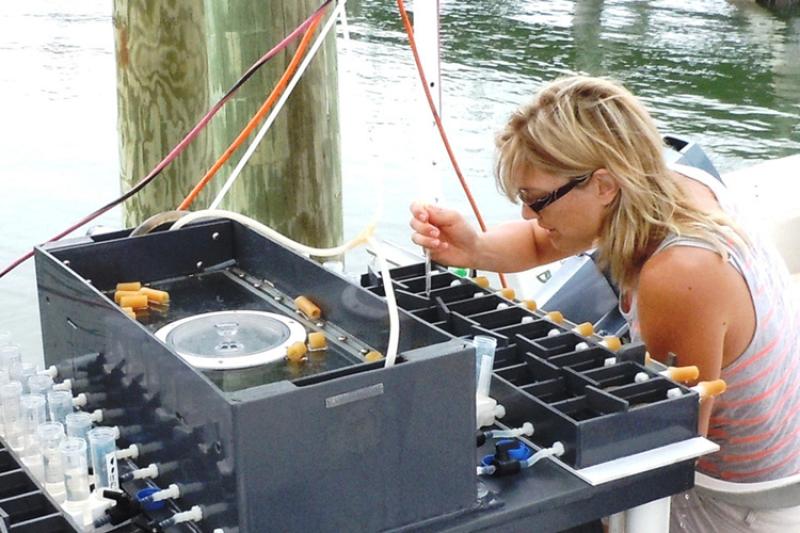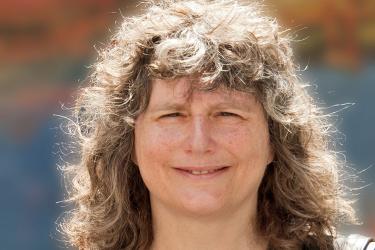Where did you grow up?
I grew up in a small town called Mooers, New York, in Clinton County, which borders Canada and Vermont. It is about 40 minutes south of Montreal and had a population of less than 3,000 people when I lived there.
Where did you go to school and what did you get your degree(s) in?
As an undergraduate I attended the State University of New York at Plattsburgh and earned a double degree in environmental science and chemistry. While there I took a course in water chemistry and was fascinated at calculating chemical speciation, the distribution of an element among chemical species, in seawater environments. Although I had never seen the ocean, I was determined to continue my education by focusing on the ocean. Off I went to Norfolk, Virginia and Old Dominion University. I worked with Gregory Cutter on sediment fluxes and selenium speciation while obtaining a Ph.D. in oceanography with a concentration in chemistry. My love for sediments had started at a young age. I would make mud pies for my family to eat, and now I could combine that interest with chemical speciation! My research at Old Dominion evolved into understanding and modeling how the chemical speciation of an element in an estuary is influenced by many physical, biological, and chemical processes.
Tell us a little about how you came to work at the Northeast Fisheries Science Center.
As I was finishing up my dissertation and applying for positions I came across the job announcement at Milford Laboratory. It seemed like a great opportunity. During the interview I remember thinking “I want to be able to apply my chemical knowledge of the environment to help with aquaculture and fisheries issues.” I was offered the job the week of my Ph.D. defense and immediately accepted! I spent a month doing corrections, turned in my thesis, and moved from Virginia to Connecticut.
What do you do at the Center?

My career has evolved during the 17 years that I have been working for the Northeast Fisheries Science Center, but my research has always focused on trying to address the question of how chemistry may affect our living marine resources. I had the pleasure of being able to work a year with Center colleagues at our field station in Orono, Maine assessing the chemistry in the Penobscot River during the time of year when smolt move to the ocean. In recent years my research has been focused on ocean acidification. As the Northeast experiences warmer water temperatures and increased atmospheric carbon dioxide, the carbonate chemistry of the ocean and estuaries are changing. This may have an effect on federally managed fish and shellfish species and on aquaculture production on the East Coast. I am fortunate to work with a great team of people at Milford and within the Center, and to partner with our fisheries lab in Kodiak, Alaska to address some of the physiological responses of organisms to ocean acidification. I also work with our academic partners and the shellfish industry to try and answer questions on how ocean acidification will affect oysters, surfclams, and sea scallops.
What do you like most about your job?
If I had to summarize what I like the most about my job in one word, it would be people. I have had the experience of working with a variety of colleagues within the Northeast Fisheries Science Center and within NOAA Fisheries, with our constituents, and with collaborators at academic institutions in the United States and internationally. They come from many states - Washington, Alaska, Maine, New York, New Jersey, and Virginia - and internationally from organizations in France, Norway, Canada, Spain, Brazil, Japan, Chile, and South Korea. I also like building lab spirit at Milford by working with staff to hold ice cream socials and costume parties for lunch on Halloween.
What are some of your hobbies?
I have many hobbies and most of them keep me moving. I am an avid runner and have participated in races ranging from a 5K to a full marathon. I’ve completed 13 marathons to date. I even did the Goofy challenge, where I ran a half marathon on Saturday and a full marathon 24 hours later on Sunday. Now that I have a son, I have been focusing on smaller races due to the time commitments required to train for a full marathon.

I recently started hiking the Appalachian Trail with my 12-year-old son, Quintin. We’ve completed over 100 miles of the trail and hope to complete as much of it together as possible. He loves science too, but his passion is at the molecular level. I can see him pursuing something like quantum physics.
When I have time, I also love to cook. I have been known to bring in brownies, scones, cookies and other desserts to the laboratory to share with coworkers. Lately my cooking time has decreased as we just added a German shepherd/Labrador mix puppy named Simon to our family. Luckily our two cats, Little Man and Lady, and Simon get along great!



